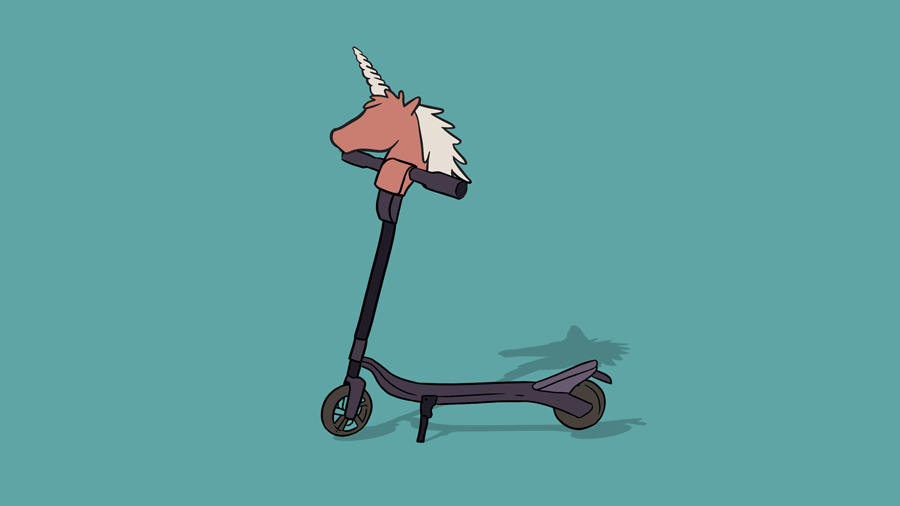Morning Markets: Scooters are a terrible investment! Scooters are a great investment!
If you can recall all the way back to last week, you will remember news that Bird, a popular American scooter company, lost $100 million earlier this year as both its net, and gross revenue declined. The first quarter wasn’t overly kind to Bird, a firm which has raised huge sums of money in the name of growth.
Subscribe to the Crunchbase Daily
The timing of Bird’s revenue decline wasn’t entirely a surprise as the first quarter included traditionally inclement months during which scooters are likely less popular — you can’t scoot in the snow. And, we knew Bird was running at a deficit, making the only surprising thing the scale of the loss compared to the size of its temporarily embarrassed revenue result.
Things, naturally, have become more complex. Bird’s CEO Travis VanderZanden uncorked a few tweets after the first story was published, firing back at the new narrative coalescing around his firm and industry.
The negative theme that VanderZanden wanted to combat went something like this (my words, not his – that comes later): Sure, everyone knew that scooter companies were having a harder time than expected squeezing margin from their popular two-wheeled machines. But $100 million in a single quarter against a revenue result of just 15 percent that total? That’s worse than expected.
VanderZanden’s various tweets included enough different data points, and implied arguments, that I think we’ll do some work this morning to unspool them. Let’s get into it.
Tweets
In order, here’s a summary of what Bird’s CEO tweeted, with our notes following each bullet point (tweet):
- Tweet One: The Information’s story was fake news.
Bird did lose the $100 million that The Information reported, something that VanderZanden confirms in his fifth tweet. However, the CEO begins his tweetstorm by calling their reporting “fake.”
- Tweet Two: Bird is growing rapidly.
The CEO posted a chart, showing what is presumably Bird’s revenue run rate (not ARR, mind) over time. The chart shows that the company’s revenue fell precipitously during the winter months, matching the direction of The Information’s reporting.
VanderZanden states that Bird’s run rate is up “over 4x from this time last year.” The data point has little to do with what The Information reported regarding Bird’s revenue declines from Q4 2018 to Q1 2019, something the CEO’s own chart appears to defend.
In his third and fourth tweets, Bird’s CEO states that its Bird Zero scooters (75 percent of its in-market units) generate $1.27 of contribution margin on “every ride.” This means that each Bird Zero scooter ride, after paying for itself, provides $1.27 to help fund the company’s operations.
The stated margin includes depreciation, and “in-market support.” That’s good, and makes the resulting contribution margin figure seem sturdy.
Tweet four digs into how the $1.27 result is calculated, including the gross spend from a customer that is used to run the math that results. Bird scooters are grossing $4.27 per ride. That’s up from the last time we heard the figure ($3.65 in gross spend per ride). So, Bird has managed to grow its average ride cost by about 17 percent if we’re correctly comparing sums (always tough to do with non-public companies).
Reading the CEO’s table detailing the company’s resulting per-ride “Pro Forma Contribution,” two final things jump out. First, that Uber and Lyft each generate negative contribution from each ride they support according to the presented math. This is a non-subtle diss from the scooter company against the larger and more valuable ride-hailing companies.
And, second, that Bird books no sales and marketing costs that are shared on a per-ride basis. That’s to say that Bird doesn’t count any sales and marketing spend costs in its per-ride revenue and costs calculations. If Bird boosts sales and marketing spend, you can see where it will ding margins simply.
- Tweet Five: Bird did lose $100 million, but it was a write-off due to an accounting mistake (“our original depreciation window was too long”) and not something you should care about.
Let’s be clear, Bird had to write off $100 million in scooter value because it expected those machines to last longer than they did. That’s not good. Trying to spin losing $100 million, spent money raised by selling shares, that you didn’t expect as not a big deal is odd and oddly aggressive.
VanderZanden also details a lack of maturity by calling The Information “DisInformation,” which isn’t witty in the slightest. Nor is it accurate. Especially when the CEO himself states that “[w]e sent this data to the reporter.” I can’t quite figure out why the CEO is unhappy about a publication reporting data that was shared with it. But, hey, I didn’t lose $100 million in Q1 2019.
So What?
If Bird’s CEO had simply followed up The Information’s story by saying “our first quarter was hard, but we’re generating $1.27 per ride today and we think our business has never been more viable,” all this would have been easier. Instead, by attacking the press for reporting accurate numbers, albeit in a manner that he didn’t approve of, VanderZanden put a bad taste in my mouth and lowers market trust in himself.
Let the numbers do the talking; let the Trumpian insults stay untweeted.
What we know is that Bird’s own math shows scooters’ margins and results improving. That should help the firm raise the money it needs to. Just don’t forget that each Bird ride generates positive contribution, which is not the same thing as the company itself making money.
Here’s one way to think about it. For every one million rides that Bird supports in any given quarter, it generates $1.27 million in margin that it can use to fund its corporate-level costs. Those include engineering, its executive group, its government relations work, and so forth. How many rides it will need to power to break even I don’t know, but if you do, please get in touch.
Precisely how the scooter industry will shake out in time isn’t clear. I only have guesses. But if Bird’s math holds, and works for other companies like Lime and the rest, perhaps some of the scooter legions will make it.
Illustration: Li-Anne Dias.

Stay up to date with recent funding rounds, acquisitions, and more with the Crunchbase Daily.




![Illustration of a guy watering plants with a blocked hose - Global [Dom Guzman]](https://news.crunchbase.com/wp-content/uploads/quarterly-global-3-300x168.jpg)
67.1K Followers